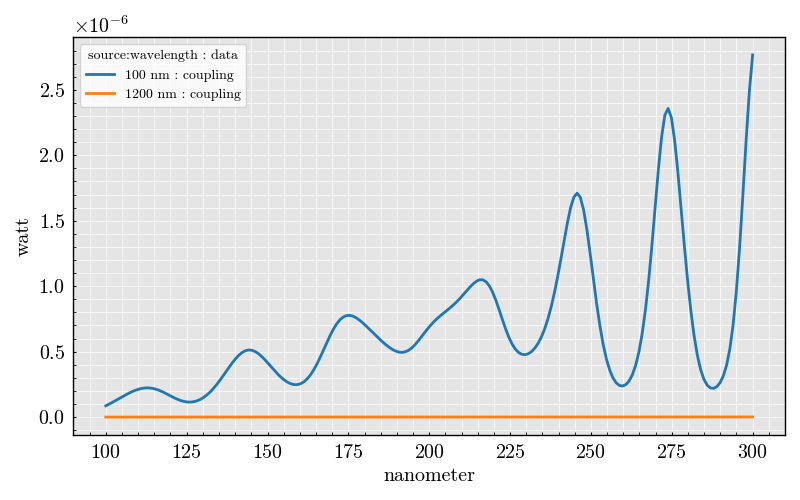Note
Go to the end to download the full example code.
Cylinder: Coupling vs Diameter#
This example demonstrates how to compute and visualize the coupling efficiency as a function of diameter for cylindrical scatterers using PyMieSim.
Importing the package dependencies: numpy, PyMieSim
import numpy as np
from TypedUnit import ureg
from PyMieSim.experiment.detector import Photodiode
from PyMieSim.experiment.scatterer import Sphere
from PyMieSim.experiment.source import Gaussian
from PyMieSim.experiment import Setup
Defining the source
source = Gaussian(
wavelength=[100, 1200] * ureg.nanometer, # 1200 nm
polarization=90 * ureg.degree, # Polarization angle in ureg.degrees
optical_power=1e-3 * ureg.watt, # 1 milliureg.watt
NA=0.2 * ureg.AU, # Numerical Aperture
)
Defining the scatterer distribution
scatterer = Sphere(
diameter=np.linspace(100, 300, 200)
* ureg.nanometer, # Diameters ranging from 100 nm to 3000 nm
property=[1.4] * ureg.RIU, # Material of the cylinder
medium_property=1.0 * ureg.RIU, # Refractive index of the surrounding medium
source=source,
)
Defining the detector
detector = Photodiode(
NA=[0.1] * ureg.AU, # Numerical Apertures for the detector
phi_offset=[-180.0] * ureg.degree, # Phi offset in ureg.degrees
gamma_offset=[0.0] * ureg.degree, # Gamma offset in ureg.degrees
sampling=600 * ureg.AU, # Number of sampling points
polarization_filter=None, # No polarization filter
)
Setting up the experiment
experiment = Setup(scatterer=scatterer, source=source, detector=detector)
Measuring the coupling efficiency
dataframe = experiment.get("coupling")
Plotting the results Visualizing how the coupling efficiency varies with the cylinder diameter.
dataframe.plot(x="scatterer:diameter")

<Figure size 800x500 with 1 Axes>
Total running time of the script: (0 minutes 0.332 seconds)
